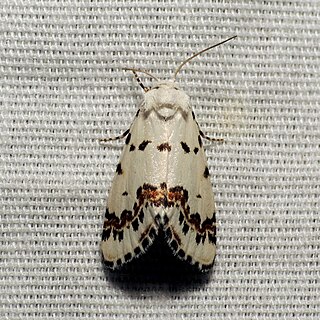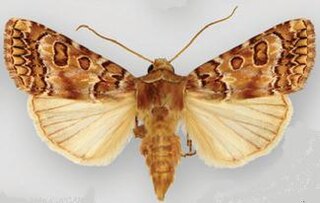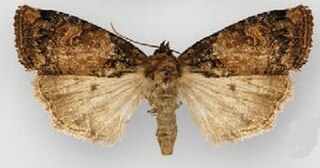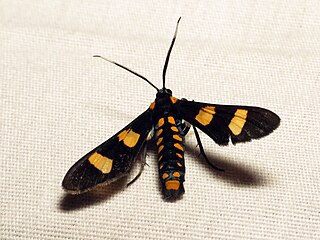Afotella is a monotypic moth genus of the family Noctuidae erected by William Barnes and Foster Hendrickson Benjamin in 1926. Its only species, Afotella cylindrica, was first described by Augustus Radcliffe Grote in 1880. It is found in western North America from Saskatchewan and Alberta south to California.
Isogona is a genus of moths of the family Erebidae.
Mimobarathra is a genus of moths of the family Noctuidae erected by William Barnes and James Halliday McDunnough in 1915. Its only species, Mimobarathra antonito, was first described by Barnes in 1907. It is found in the US state of Arizona.

Grotella tricolor is a species of moth in the genus Grotella, of the family Noctuidae. This moth is found in the US states of California and Arizona. It was first described by William Barnes in 1904.
Grotella citronella is a species of moth in the genus Grotella, of the family Noctuidae. This moth is found in North America, including the Mojave Desert region of California. This species was first described by William Barnes and James Halliday McDunnough in 1916.
Cryphia cuerva, the cryphia moth, is a moth of the family Noctuidae first described by William Barnes in 1907. It is found in western North America from British Columbia and Alberta, south to California.
Cryphia nana is a moth of the family Noctuidae first described by William Barnes and James Halliday McDunnough in 1911. It can be found in the US state of California.

The thin-lined owlet is a species of moth of the family Erebidae. It is found from Ontario, Wisconsin, Ohio and New Jersey, south to Florida and Texas.

Lasionycta poca is a moth of the family Noctuidae first described by William Barnes and Foster Hendrickson Benjamin in 1923. It is found throughout the Rocky Mountains of Alberta, westward to the Coast Range in western British Columbia and southward in the Cascades to Okanogan County, Washington.

Hypagyrtis esther, the esther moth, is a moth of the family Geometridae. It was first described by William Barnes in 1928 and it is found in the United States from Massachusetts to Florida, west to Texas, north to Ohio.

Oxycnemis acuna is a moth of the family Noctuidae first described by William Barnes in 1907. It is found in North America, including Arizona and Texas.

Tarache idella is a moth of the family Noctuidae first described by William Barnes in 1905. It is found in Arizona and Texas.

Hypotrix hueco is a moth of the family Noctuidae first described by William Barnes in 1904. It is known only from south-eastern Arizona in the United States.

Bryolymnia ensina is a moth of the family Noctuidae first described by William Barnes in 1907. It occurs in coniferous forests from south-eastern Arizona and south-western New Mexico southward in the Sierra Madre Occidental to the State of Durango in Mexico.

Stagmatophora wyattella, or Wyatt's stagmatophora moth, is a moth in the family Cosmopterigidae. The species was first described by William Barnes and August Busck in 1920. It is found in the US states of Maine, Ohio, Iowa, Kentucky, Michigan, Mississippi and Oklahoma.
Decaturia is a monotypic snout moth genus. Its only species, Decaturia pectinalis, is found from California to southern Arizona. Both the genus and species were described by William Barnes of Decatur, Illinois, and James Halliday McDunnough in 1912.
Negalasa is a monotypic snout moth genus. Its one species, Negalasa fumalis, is found in the US state of Arizona. Both the genus and species were described by William Barnes and James Halliday McDunnough in 1913 in the same paper.
Alucita montana, the Montana six-plume moth, is a moth of the family Alucitidae. It was described by William Barnes and Arthur Ward Lindsey in 1921. It is found in North America from south-western Quebec and Vermont, west to British Columbia and south to Arizona, California and Texas.
Dorithia peroneana is a species of moth of the family Tortricidae first described by William Barnes and August Busck in 1920. It is found in the US state of Arizona.

Phoenicoprocta hampsonii is a moth in the subfamily Arctiinae. It was described by William Barnes in 1904. It is found in the United States in south-eastern Arizona and in Mexico's Baja California.
This page is based on this
Wikipedia article Text is available under the
CC BY-SA 4.0 license; additional terms may apply.
Images, videos and audio are available under their respective licenses.









